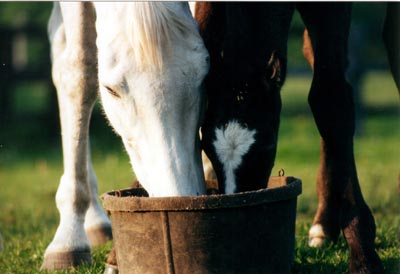archives
07/2006 - 08/200608/2006 - 09/2006
09/2006 - 10/2006
10/2006 - 11/2006
11/2006 - 12/2006
12/2006 - 01/2007
01/2007 - 02/2007
02/2007 - 03/2007
03/2007 - 04/2007
04/2007 - 05/2007
05/2007 - 06/2007
06/2007 - 07/2007
07/2007 - 08/2007
08/2007 - 09/2007
09/2007 - 10/2007
10/2007 - 11/2007
11/2007 - 12/2007
12/2007 - 01/2008
01/2008 - 02/2008
02/2008 - 03/2008
03/2008 - 04/2008
04/2008 - 05/2008
05/2008 - 06/2008
06/2008 - 07/2008
 What's 'Sweet' in Sweet Feed?
What's 'Sweet' in Sweet Feed?
Add Your Comments
Thehorse.com - Full article by: Nancy S. Loving, DVM
All the rage these days in human diets is to take the sugars out of food and keep the carbohydrates to a minimum. This same principle, that of feeding a diet low in nonstructural carbohydrates (NSC), is being applied to equine nutrition. [Many horses do not require a commercial concentrate feed at all, if they can maintain their weight on forage and a mineral supplement alone, equine nutritionists note. But some horses need more.] Considering that horses are herbivores designed to extract energy from a very different sort of diet than that consumed by humans or carnivorous small animals, let's look at what "the sweet in sweet feed" (and hay) is all about, and put how to feed sweets safely into a practical perspective.
Remember: the most important reason horses get fat is they get too many calories, not that they get too much sweet.
What's Sweet in the Feed?
Many knowledgeable equine nutrition experts work with feed companies to formulate the variety of products you find at the feed store and carry home in 50-pound sacks to your eager horse. Karen Davison, PhD, manages equine technical services for Purina Mills. She explains about sugars and starch: "NSC, or nonstructural carbohydrates, are sugars and starches present in plants..."
More...





